My Experience Growing Roses from Cut Flowers – Updated!
Some bouquets are just too beautiful to be only part of a passing moment. Take the plunge and try growing rose cuttings from cut flowers so you can enjoy those roses every single year!
If you don’t know how to root a rose cutting in water, don’t worry. I didn’t know either – but, with a little persistence and lots of patience, I am so excited to have two rose cuttings rooting in water as I type this!
I am so excited to have success at rooting rose cuttings that I’ve decided to document my journey and share the best practices so that hopefully you, too, can grow your own rose garden from cut flowers.
Let’s get started!
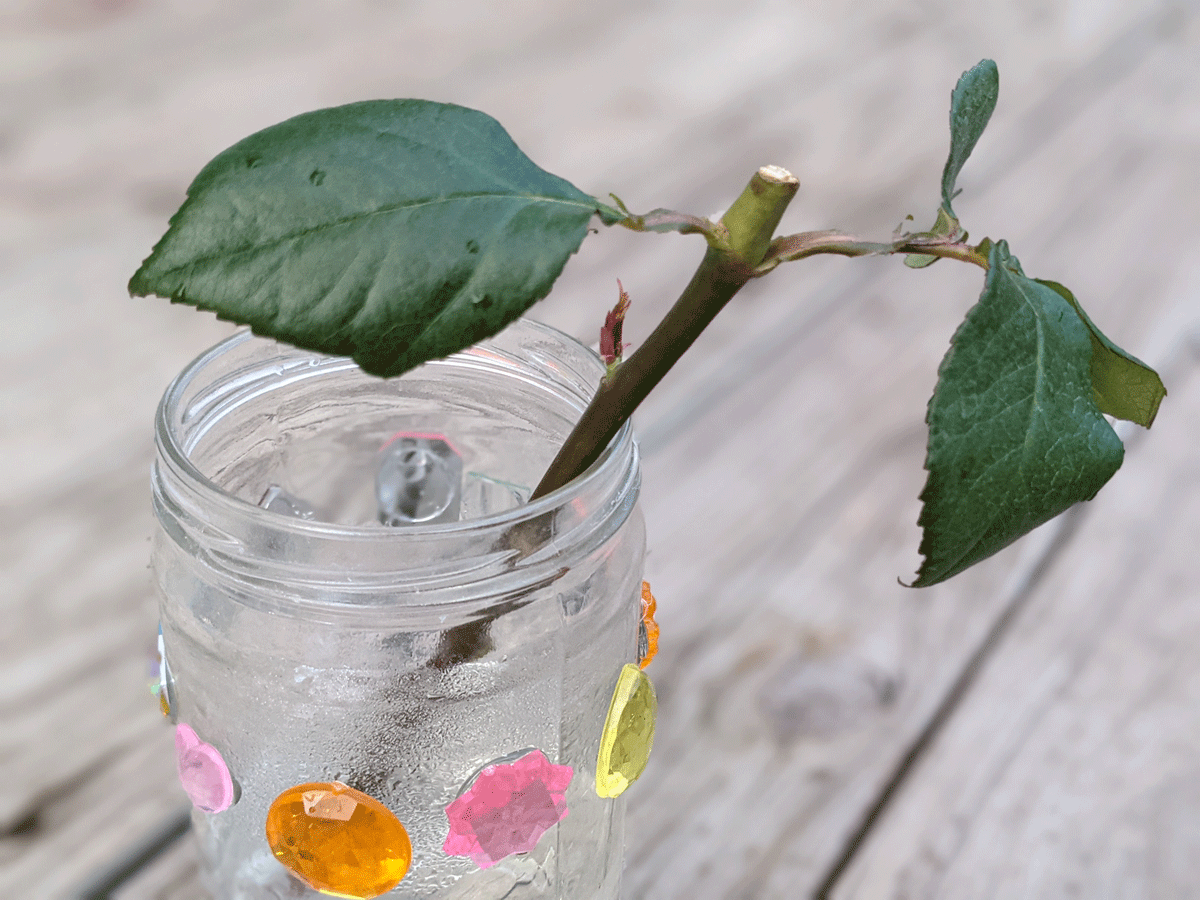
Is Growing Roses from Cut Flowers Possible?
Yes, it is possible to grow roses from cut flowers, from a florist bouquet, or one you grab from your local grocery store. Given the right conditions, some of the rose cuttings taken should begin to grow roots within a month or so of placing them in water.
As I type this, I have two rose cuttings rooting in water with real, white roots already pushing through.
I took these cuttings from a bouquet of dark pink, *very* fragrant roses from Lidl. These roses were SO fragrant I could smell them through the cloth mask I was wearing while making a quick beeline for the bulbs and flowers section of the store back in early April.
What Do Rose Cuttings Look Like
Rose cuttings look like straight stems from roses that are generally six to eight inches in length. The bottom end should be angled and each cutting should have at least a few sets of leaves and leaf nodes.
Rose cuttings can be taken from new growth, green wood, or hardwood.
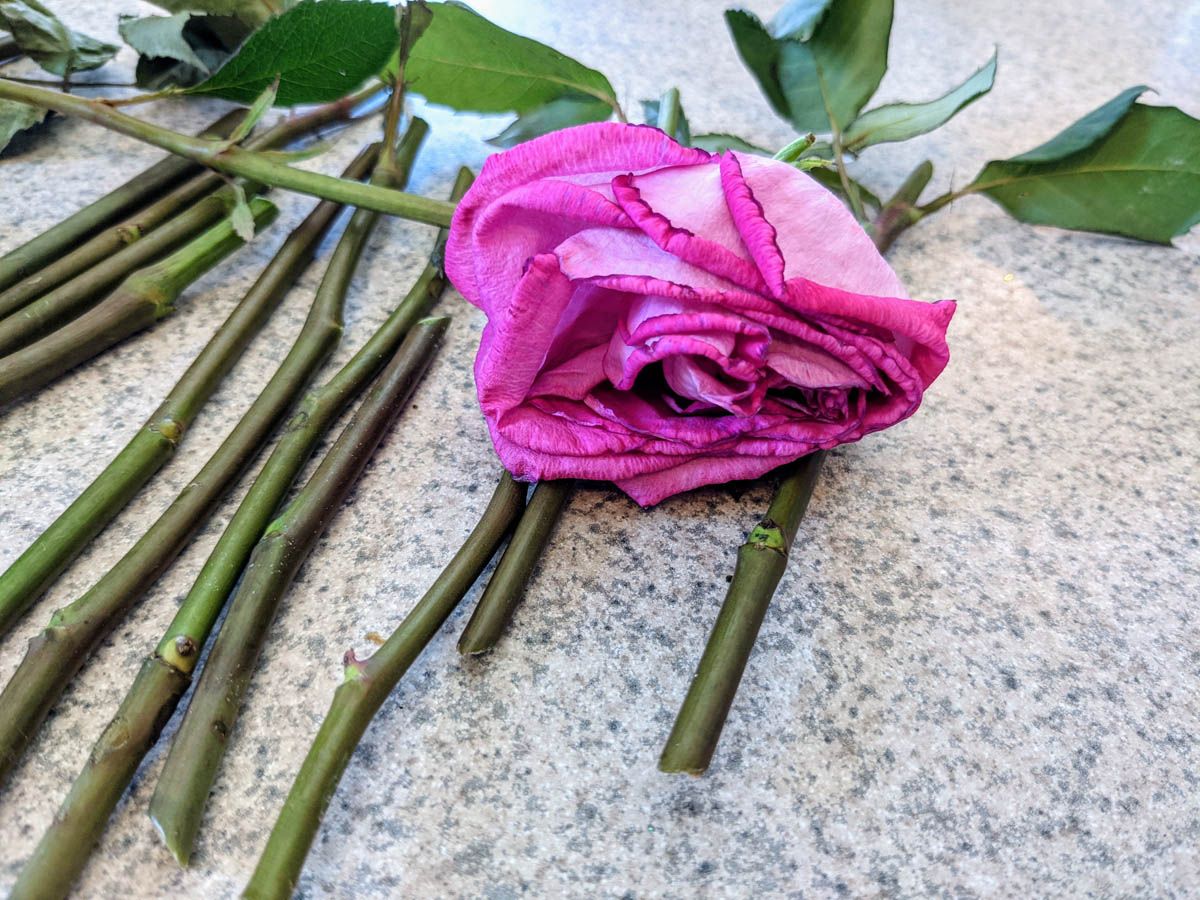
How Long Does It Take to See Roots on Rose Cuttings
Different factors like type of rose and thickness of the stem can determine how quickly you see roots pushing out of rose cuttings. You may see white roots pushing out of the bottom and side of the rose cutting in a matter of weeks or about one month after taking and starting the cuttings.
When I first attempted growing roses from cut flowers on April 6, I took a few cuttings immediately. As much as it pained me to shorten the rose stems, I found a small jar to still display the shorter rose bloom.
In many cases, you will see new leaves opening before you see roots. The lovely little leaves begin as striking red leaves that soon soften to green.
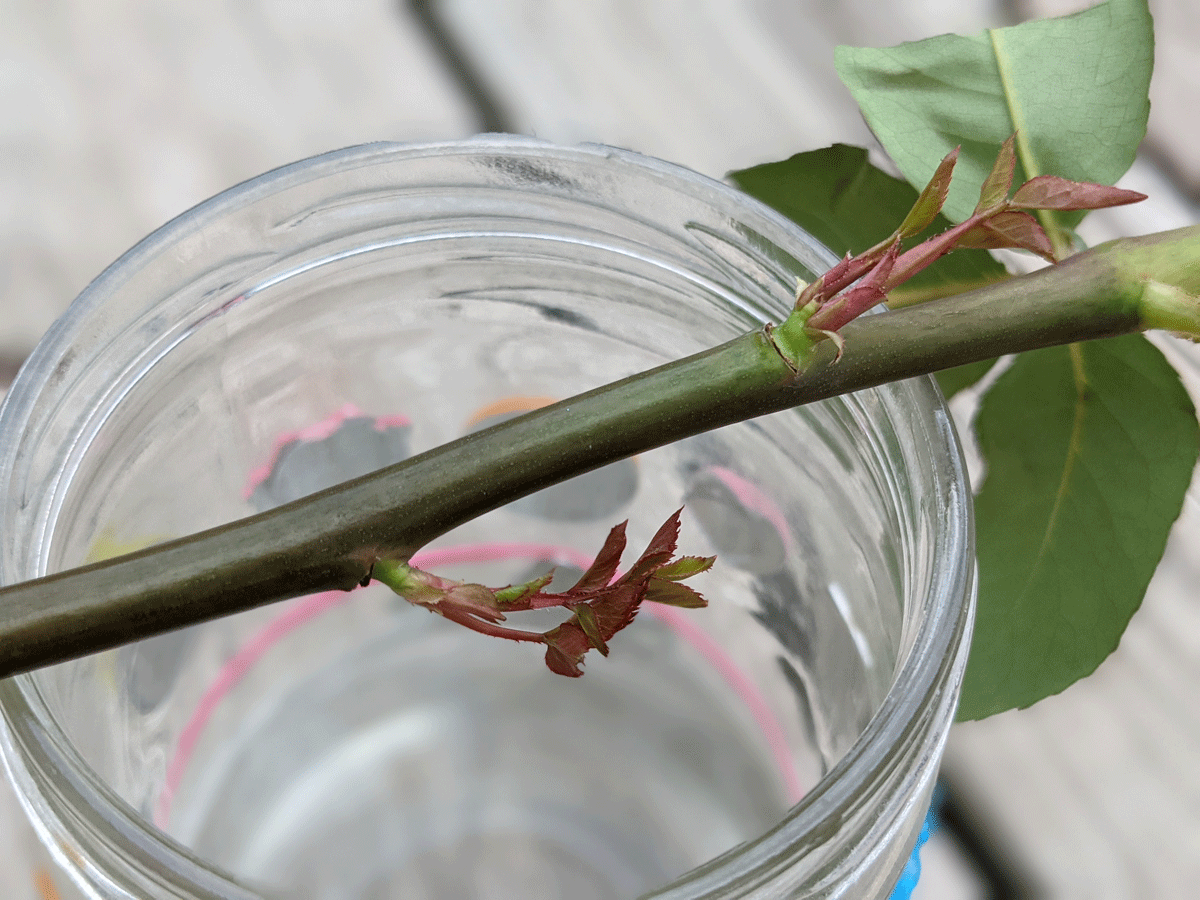
By the third week of May, I saw the stem splitting at the bottom. Soon, two white roots were pushing through the bottom of the stem.
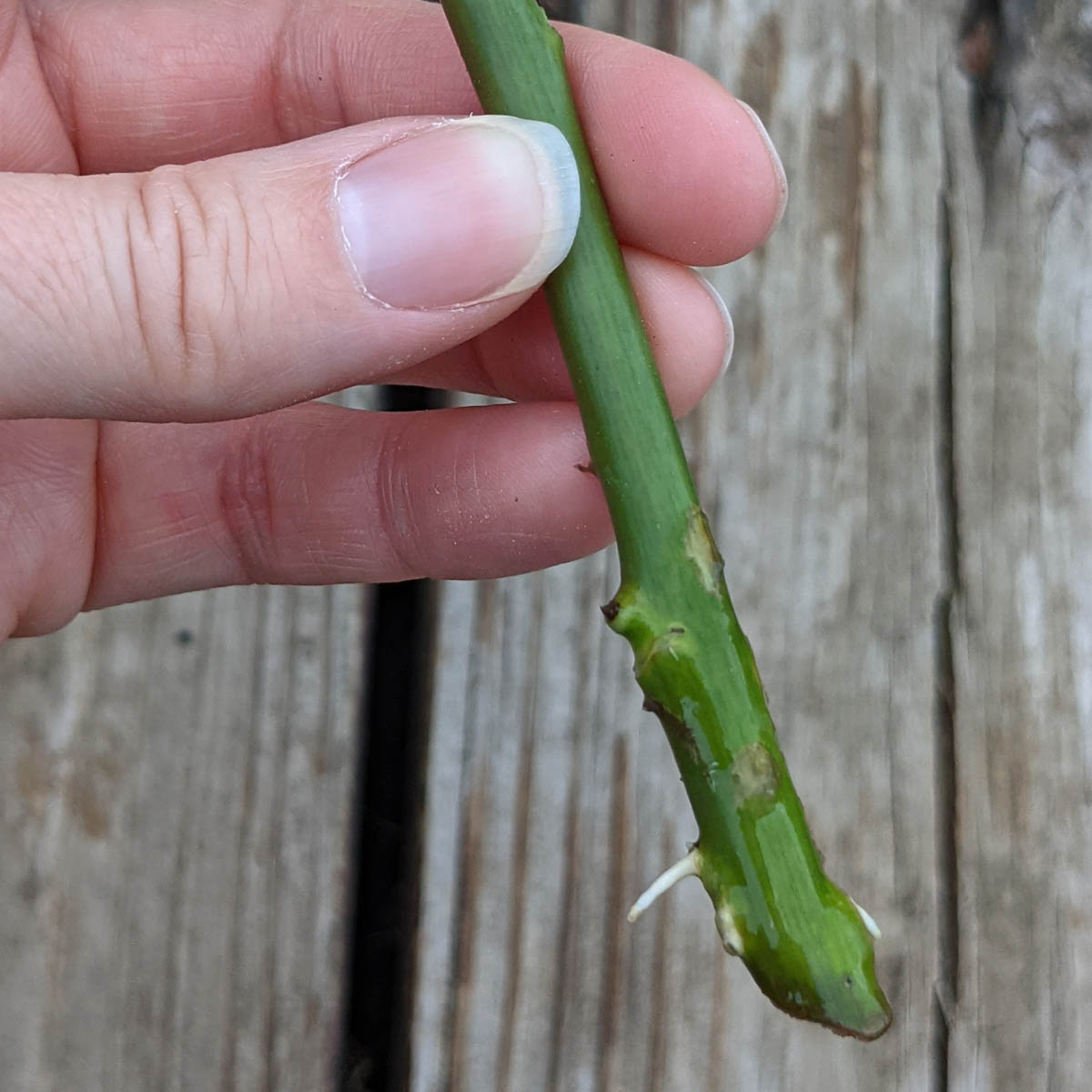
Benefits of Growing Roses from Cut Flowers
Rooting rose cuttings is a meaningful activity for any gardener! Here are some of the best benefits of rooting roses from cuttings.
- You can enjoy your favorite cut roses – forever! (If successful, which I hope you will be!)
- Who wouldn’t want free rose bushes?! All it takes is a few starter stems for cuttings, and time.
- The science experiment factor is real and so satisfying.
- Rooting roses is a kid-friendly gardening project! Enjoy this activity with your kids as a memory they’ll likely have forever. (But it’s just as satisfying solo!)
- Sell, gift, or share the extra rose bushes you successfully root. You may enjoy this project so much that it becomes a hobby (or an obsession)! Collect all the colors, share the spares!
Oh and just a tip, for your rosebushes already in bloom, don’t forget to deadhead roses to increase production and extend bloom time!
How to Grow Roses Indoors from Cuttings
Try these steps to help you discover how to take a rose cutting from a bouquet and grow a new rose bush.
First learn how to take a rose cutting and then move on to actually try to get the roses to root in water.
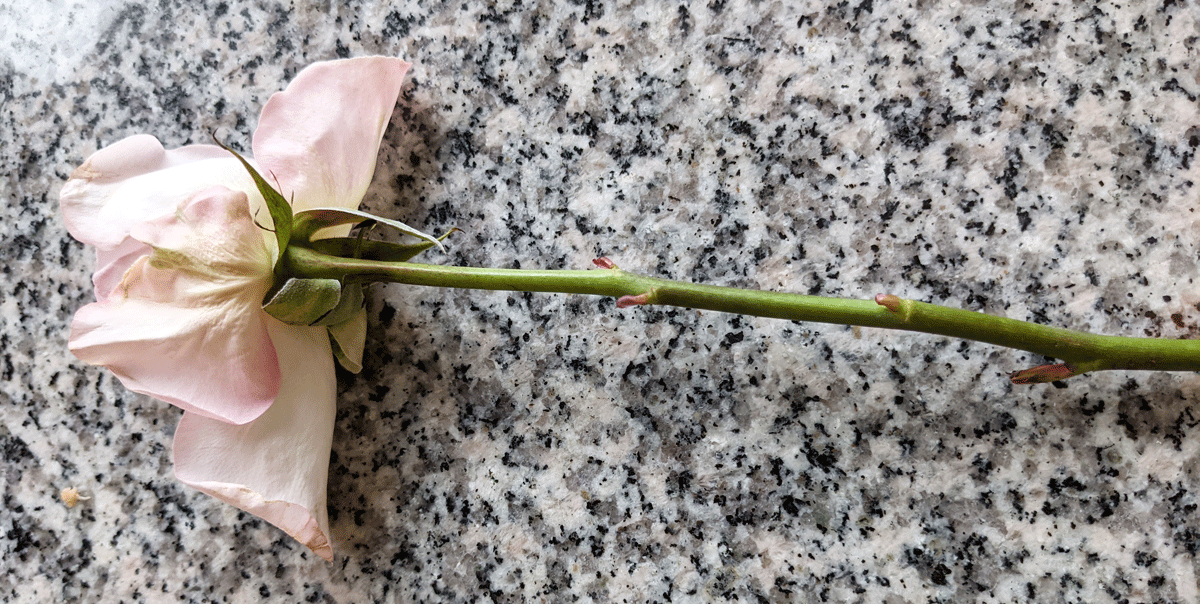
How to Take a Rose Cutting
If your goal is growing roses from cut flowers you received in a bouquet, you can take a rose cutting when you first get the flowers. This may be a tough choice since you’d surely like to enjoy the fresh flowers as well.
What I usually do is take the cuttings and then place the shorter blooms in a small vase or votive candle holder.
This way I still get to enjoy them while also having a chance to grow these stunning roses from cuttings!
- Make a fresh cut. Cut the bottom off the rose stem at a 45-degree angle under running water.
- Consider the next cut. With most fresh cut florist rose bouquets, you can usually take more than one cutting from a single long-stem rose. Make sure each cutting has at least one or two healthy leaf nodes.
- Make the next cut under water. Remember to cut at a 45-degree angle if you are making multiple cuttings from the same stem.
- Line up your cuttings on the table or counter. Gather the other materials you need to propagate roses from cuttings.
How to Root a Rose Cutting in Water
Discover how to root a rose cutting in water with these easy steps. Now that you’ve taken the cuttings, continue the process to propagate your favorite cut roses.
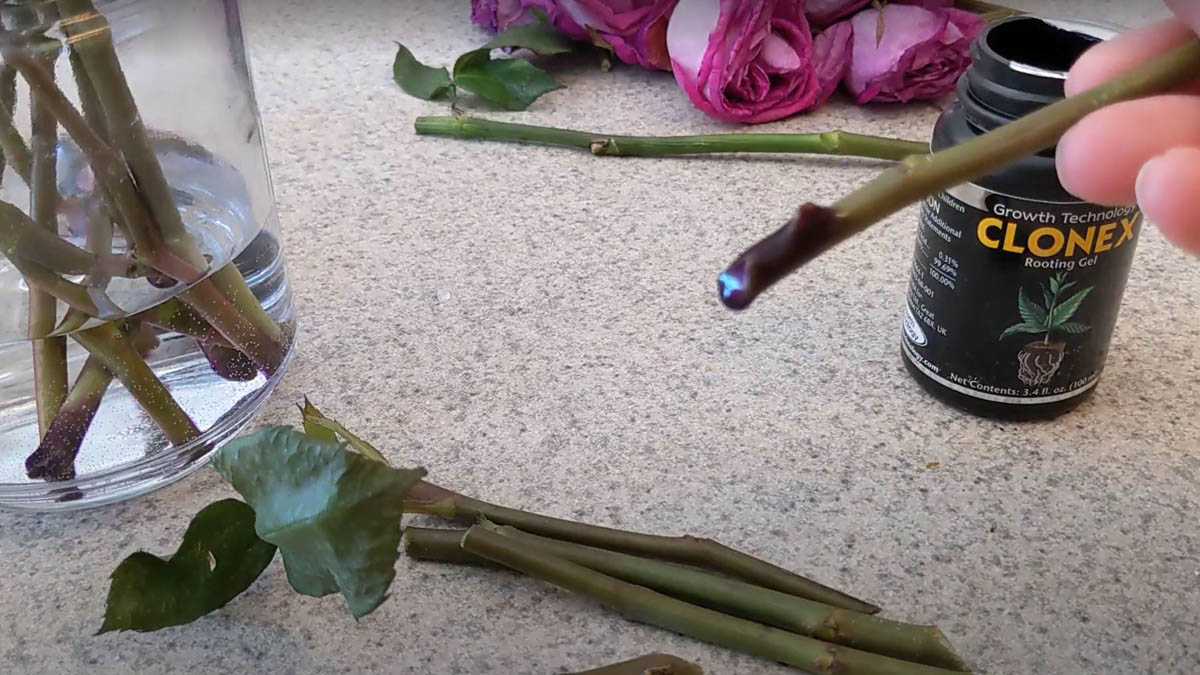
- Paint rooting hormone on the cut stems. Use something like Clonex rooting hormone gel to activate the cutting’s desire to grow roots. You can also try other rooting hormones like take root, but I recommend Clonex as I’ve already had success with that product. Some gardeners say you should avoid dipping directly in the jar to avoid introducing and spreading contaminants.
- Gently place the stems in a glass jar or vase with an inch or two of water. Check the height of the lowest leaf node and try to avoid submerging it (to prevent rot).
- Place a baggie over top of the jar. This helps create a little greenhouse that traps the warmth and moisture inside to help the rose cuttings root.
- Label the type/color of rose and the date. You’ll love seeing how long it takes to see signs of growth from the date you made cuttings. Labels are also extremely useful when you are trying to grow roses from a multicolored bouquet. I like to use masking tape or colored masking tape.
- Set the jars in indirect sunlight. I placed mine on our bay window with the sheer curtains gently filtering the sunlight.
- Change the water every other day. Some gardeners change the water daily. I’ve gone up to three days between changing the water when I’ve been busy. Be as gentle as possible when changing out the water and pay attention to the waterline so you can fill it similarly.
- Be patient. The waiting is the hardest part!
Check your roses daily to see if any new roots are pushing through the stems. Look for signs like splitting stems and white bumps indicating growth of new roots.
How to Transition Rooted Rose Cuttings from Water to Soil
I am currently working through the process of transitioning my rooted rose cuttings to soil as I type this. Several of my rose cuttings developed roots and survived thus far (late September 2021). I am trying to transition rose cuttings from water to soil without shocking them.
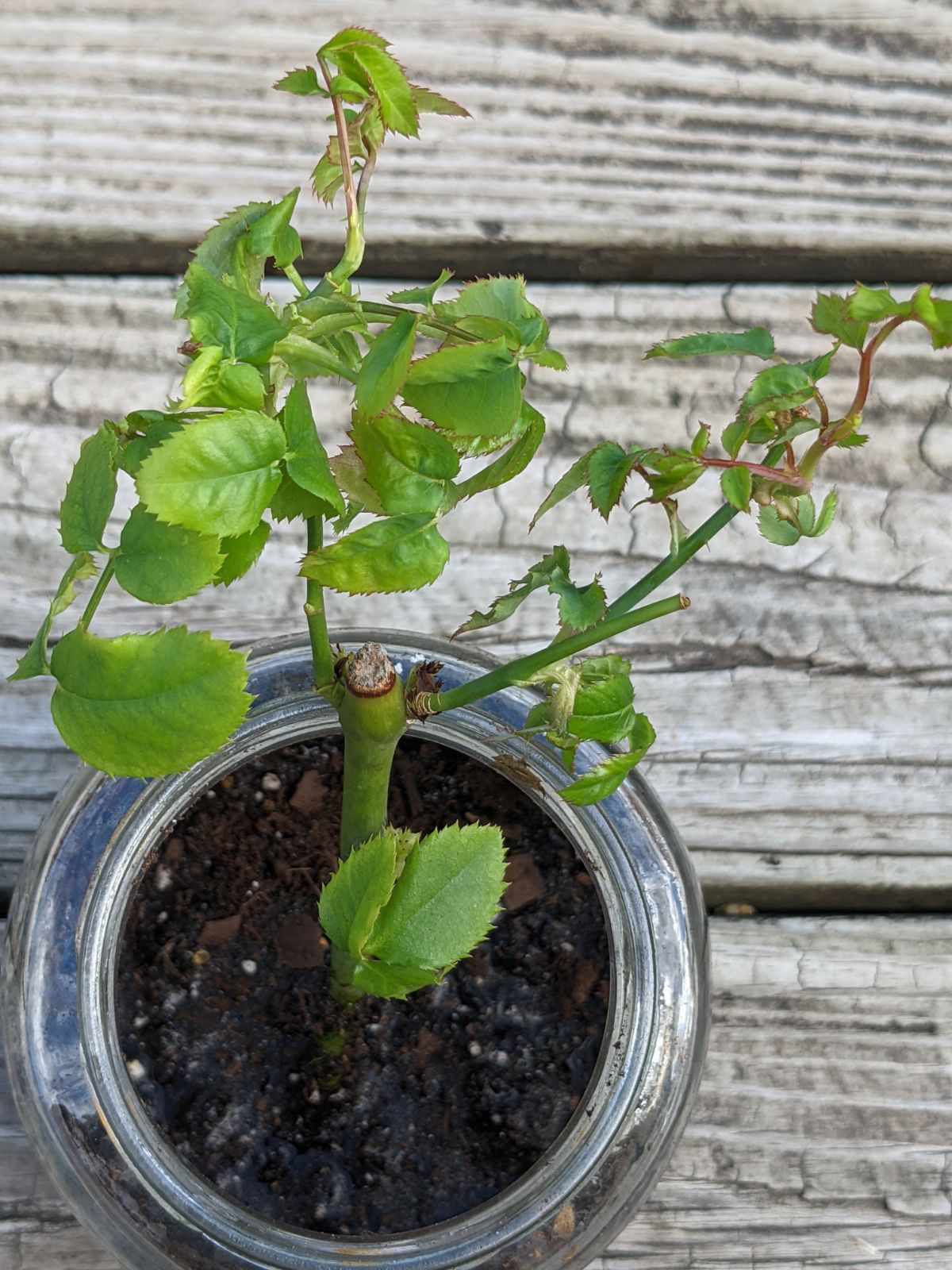
Transitioning Rooted Rose Cuttings
These are the steps I’m using to move my rooted rose cuttings into soil.
- Continue to change the water on the schedule that you’ve set for your rose cuttings.
- Consider switching your rose cutting to a plastic container or jar so it will be easier to eventually remove the rooted cutting for planting.
- With each water change, gradually add a pinch or two of potting soil to the water, or more as tolerated.
- When changing the water, use a bit of cheesecloth or cup your hand over the jar to prevent the soil from spilling out.
- As time goes on, the ratio of water to soil should shift. Soon you should have more soil than water. When the container is mostly soil, simple water the cutting as a regular plant.
- Begin to harden off the successfully rooted rose bush before planting it outdoors.
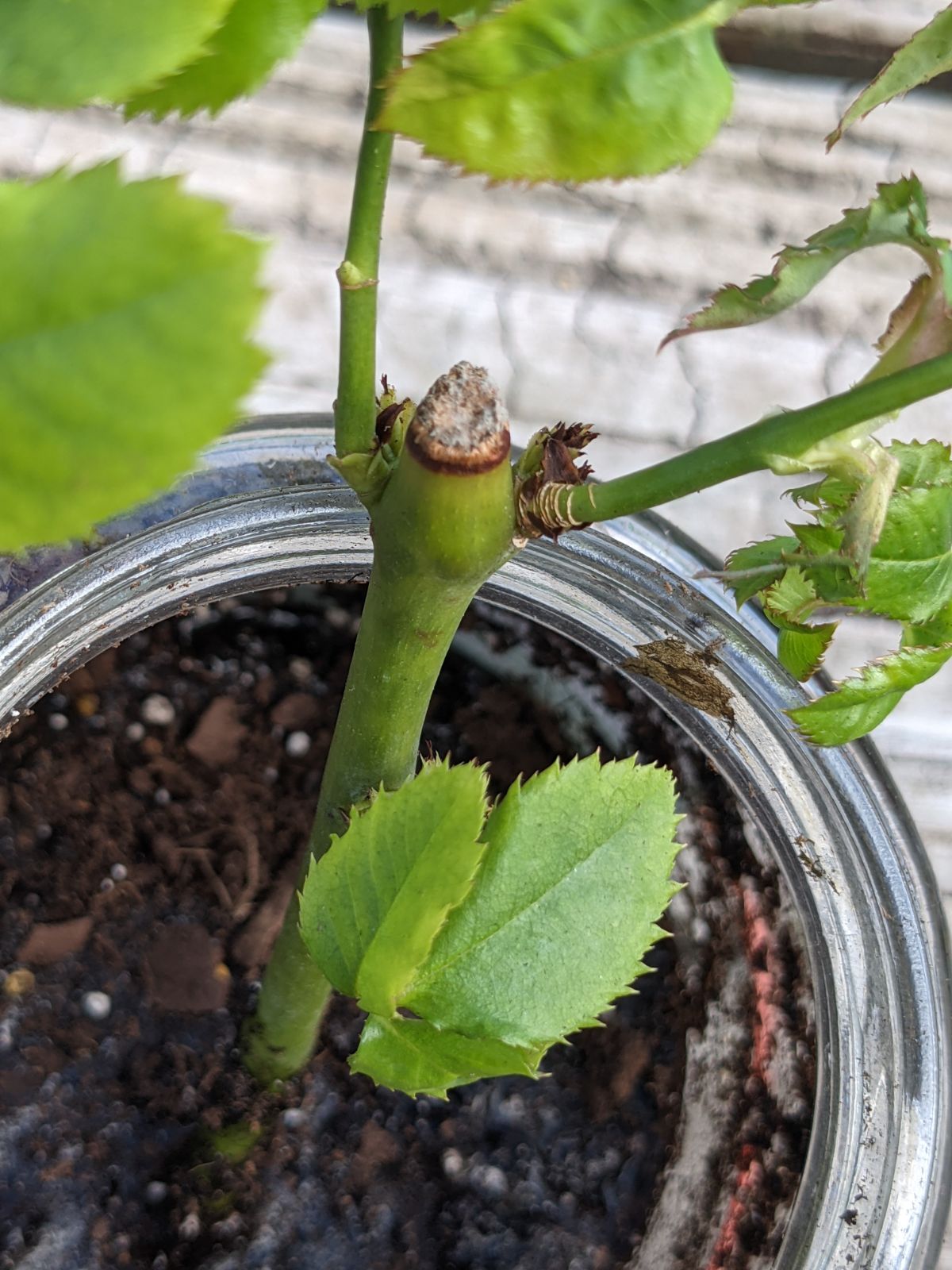
Our website features affiliate links to products that we personally believe in. If you make a purchase from a link on our site, we may earn a small commission at no cost to you. Thank you! This helps our girls chase their garden dreams! Thanks for your support. (View full affiliate disclaimer at the end of the page.)
Final Thoughts: Growing Roses from Cut Flowers
Rooting roses in water is now one of my favorite hobbies as a gardener!
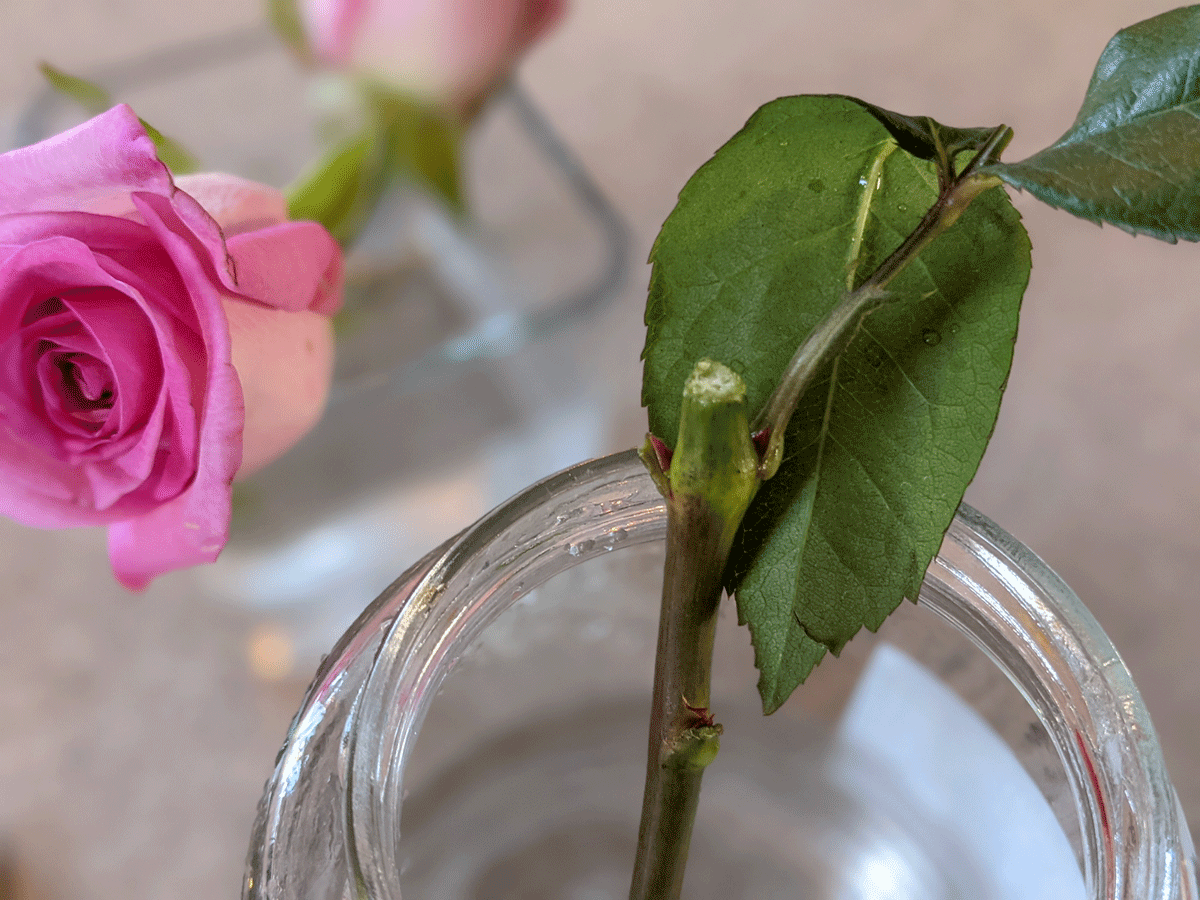
To successfully root roses in water, you need a few things.
ROSES – First, you need healthy roses as close to freshly cut as possible. The cuttings should be from roses that have already bloomed. Cut the end at a 45-degree angle and aim to have each cutting between 6 to 8 inches in length with a few healthy leaf nodes on each piece, if possible.
PROPAGATION CONTAINER – Second, you need a clean jar or container to propagate your roses. When the cuttings grow roots and become their own rose bushes, the new plants should be a carbon copy of the parent plant.
ROOTING HORMONE – Rooting hormone is not always necessary to successfully root rose cuttings in water, but it can help speed up the process and may improve your chances. Some say you can also dip cuttings in honey or cinnamon, or willow.
Getting rose cuttings to root is one of my most exciting gardening adventures so far this year! I can’t wait to enjoy my own fragrant pink roses in the garden from the bouquet I bought back in April 2021 at Lidl.
Updated Photos of Rose Cuttings
Here is the current state of my rooted rose cuttings as of September 2022!
Just check out all of these gorgeous white roots!
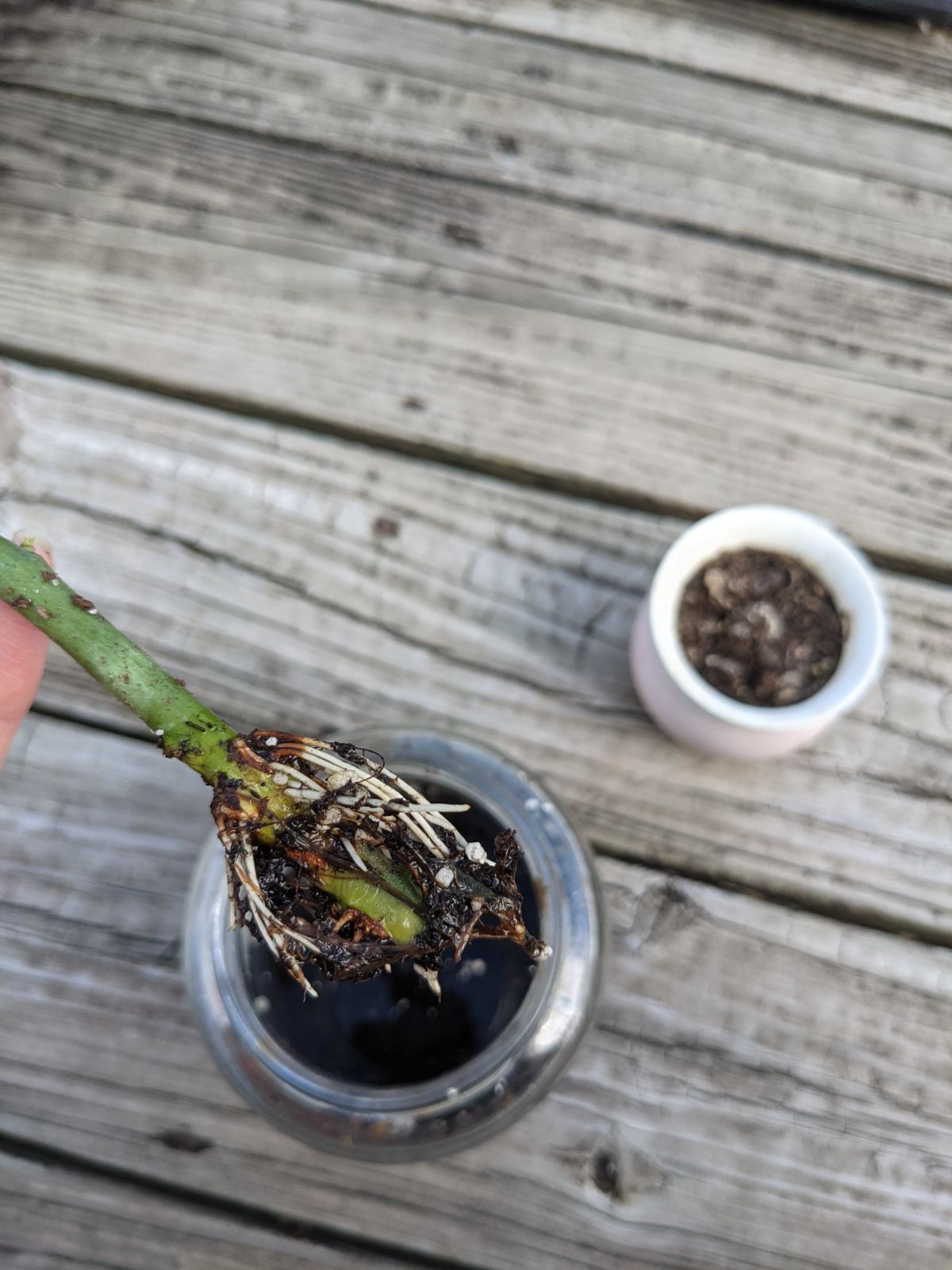
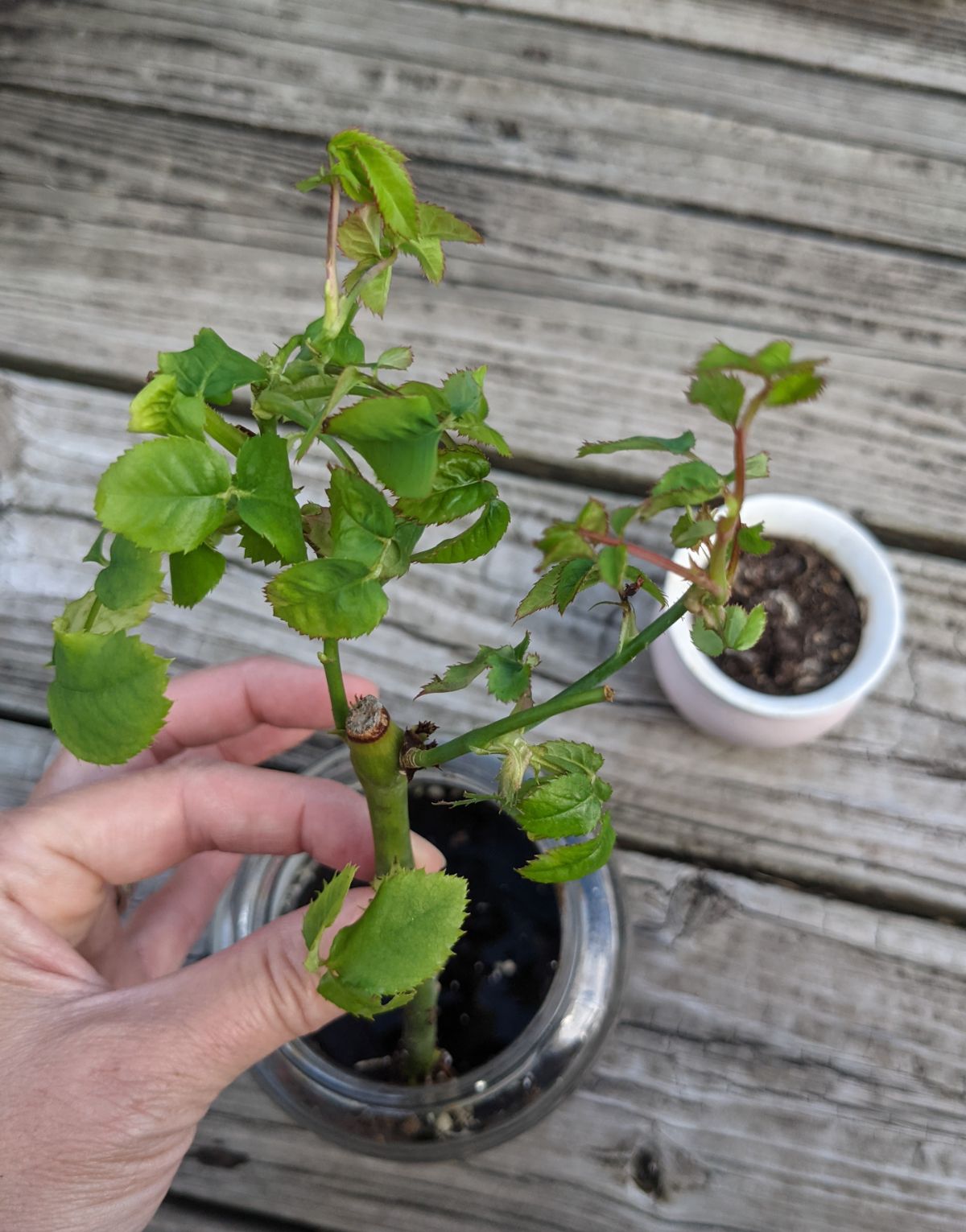
And, here’s a fun rose propagation webstory with the short-short version of how to grow roses from cuttings!
(By the way, if you like this post, you may also enjoy my posts on Propagating Blueberries from Cuttings and Growing Fig Trees from Cuttings.)
Have you tried growing roses from cut flowers? Share your successes or ask questions in the comments below!
09.27.21 – Edited to add section on transitioning rooted rose cuttings to soil.
10.04.22 – Updated to add recent progress photos. Improved spacing and bolded a missed heading. Changed existing images to full size.

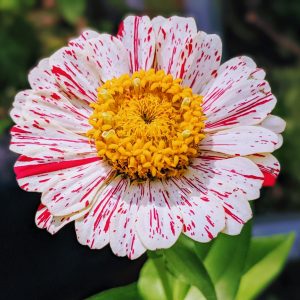


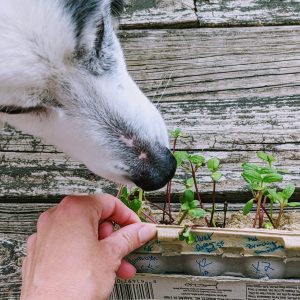

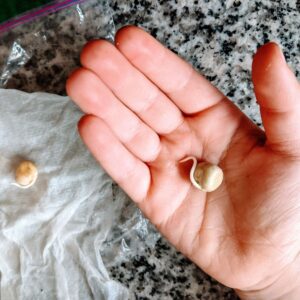
Wondering if you have to reapply the rooting hormones after changing the water.
Hi Coralie,
Thanks for stopping by – great question! I personally do not reapply the rooting hormone during water changes. I have had some good success this way. I don’t think it would hurt anything to reapply, but it will start to use up your rooting hormone product pretty quickly if you are doing daily or every other day water changes. Hope this helps! Good luck!
– Kate
Very nicely explained
Thanks, I am glad if it was clear and helpful! 🙂
Question…will this work on
. I have regrowth of leaves already from trimming them down.
Can I cut the off?
Will this work on wilted roses? I already have regrowth of leaves from trimming them. The roses are from the 8th of November and have now past their prime.
Hi Valerie! Thanks for your comment. I think there’s a good chance it could work. My results have been about 50/50 with roses that I enjoyed as an arrangement in a vase first. Cut the flowers off and try to root the stem cuttings – I think the regrowth of leaves is a good sign it wants to live. 🙂 I’ve seen leaf growth first followed by root growth most of the time. With just one rose cutting, I did get roots first and I am still waiting for the leaves to grow!
Good luck!
Hi! My roses are still in water in a vase that I change about every five days. Some I lopped off the spent rose, others I left on bc I wasn’t sure what to do. All have sprouted beautiful green leaves, two have new rosebuds, none have roots. What do I do?
Hi Lidia! Thanks for your comment – it sounds like you are having a great experience so far with rooting rose cuttings in water. Mine haven’t formed buds yet, that is so impressive! How long have you had yours in water? Have you tried any rooting hormone on the ends? If not, I’ve had good luck with Clonex on mine. Let me know and I’ll try to help! Good luck!
I have leaves growing out of my wilted roses. I am not sure what to do whether I should cut the wilted part off (top and bottom) so the plant can keep growing. What do I do? Would love to let this plant grow. Thanks!
Hi Shiela, that’s so exciting! Have you snipped off the bloom at the top yet? That would be the first step I recommend. Look at the bottom to see if it is bulging. That can indicate roots are forming, but it can take months so don’t be discouraged if you don’t see it yet. That way the rose cutting can focus its energy on growing roots and leaves. Do you have any rooting hormone? That can help the process along. If not, you can also try honey or just with water. I’d replace the water every other day. You can also trim off wilting leaves, but if you have some healthy looking ones, I’d leave some of those. I hope it takes for you!
Will only water root my rose?
Hey I’m trying to root my rose stem will water work? Thanks
Hi Beverly! Good luck with it! I’ve used water and rooting hormone with decent success! It is possible that it could root in just plain water – my best success was with Clonex gel. I hope it takes for you. 🙂
When you use clonex could you please tell me what your process is. Like do you use clonex then place them in soil cover with plastic bag place in sun check or mist every so May days etc etc. I must be doing something terribly wrong. I can’t believe it’s this hard to grow roses I can grow any other plant from pieces but roses ugh!!
Help !
Hi Dolores! Thanks for your question – I hope I can help! I will say my rose propagation is not 100% successful by any stretch. I am actually in the process of building a cloning station and will post about that soon. I cut the stems at 45 degrees with 2-3 leaf nodes, removing the flower. I dip the end in Clonex or paint it on the bottom of the stem. Then I secure a clear plastic bag (inflated) over the jar and secure with a rubber band. I replace the water every other day or so. Misting the leaves if I think of it. So far I’ve rooted several roses in water with just dipping in Clonex. It takes a LONG time in my experience! Good luck and please keep us posted! Sending you all the good vibes!
I have Take Root rooting hormone from Schultz will this work to grow roses from bouquet flowers in water.
Hi Dolores, thanks for your comment! I think you should give it a try! I’ve heard some gardeners have had success with Take Root. I have an older bottle of it from many years ago and I was not successful when I first attempted rooting roses, but I was not well informed about the process back then.
Best of luck in getting your roses to take root!
Had no idea that you could grow a rose bush from a cut flower. Last April 15th I was given a beautiful long stemmed rose which I put in a bud vase. While it was still in full bloom it started to grow a branch. By the end of April the branch was 6” long, still no root. I did not change the water but kept topping up the water to make sure it did not dry out. The flower was still hanging on as well. It started to grow roots before the flower died. Didn’t know what to do with it, but it obviously wanted to live. A few weeks later I managed to get some perlite, and in potting the rose in good soil, put at least a 2 1/2” ball of perlite in the middle of the pot, protecting the roots of my baby. When the weather was more predictable I put it outside on the deck where it would get the morning sun, but be protected from the hot afternoon. Still did not know what to expect, but by Aug. 18th I had a full-sized rose on my twig, and a new branch! That was the beginning of a growth spurt! A week later, maybe another 6 branches! The flower continues to be beautiful, now growing on what looks like quite the small rose bush. I live in NB, Canada, so plan on keeping my baby in the house this winter and planting it outside next spring.
Life in all its forms, what a gift from the Creator!
Hi Annah, wow, I love your story SO much – thank you for sharing it with us. The journey is so amazing and you are right – that rose did want to live and it was meant to become a part of your gardening experience. I am so happy you have a healthy, happy plant now. I would love to hear how it goes when you plant it out in the spring. Blessings and best wishes to you and your garden!
Oh! That sounds beautiful 🙂 I used to live in New Brunswick, but have been in Saskatchewan for decades. I just bought a bouquet of 6 roses and some babies’ breath. They were grown in Colombia. They are so beautiful!!! They are huge! Like 4 or 5 inches across!!! I already put that preservative packet in the water… and I bought the roses I think 2 days ago… I’ve had them for 2 nights I believe. They are getting bigger and bigger! The blooms are expanding! It’s so exciting! 😀 Really it is! 🙂 <3 So, now that I put in the preservative packet, will they still grow roots? I hope so! Do you think they will grow here and over-winter ok? Thanks! Peace, Rachel.
Hi Rachel! Great to hear how amazing your roses are doing! I bet they are stunning – what colors did you get? I think the preservation packet should hopefully be okay – is it just flower food? I think the biggest thing is at some point snipping a piece of stem before the blooms fade too much so the stems can focus on making roots. 🙂 Shorter vases are great for the blooms when you go to propagate the rose cuttings at the same time! Depending on the variety, I think they could be okay through the winter in Canada, however I am not sure since they are from Colombia. Maybe do a little research on the type – you could also grow them in a pot for indoor wintering or plant in a sheltered location. Best of luck with it – wishing you much luck and success!
Hi, I hope you still reply to comments!
I’m trying this method, and I’m hoping you can help. After about 2 hours I noticed that my gel had all kind of slowly seeped off of the cutting into the water. Is that normal, or does that mean that I have a watery batch? Thank you for any help!
Hi Rhonda! Thanks for your comment and hope this gets to you in time! I was a little behind with some family stuff but very much still look forward to reading and responding to all of you! xo
That happens to me as well with the gel slipping off. Sometimes it dyes the bottoms of the stems purple and sometimes it looks like it was never there. I am still trying to pinpoint the highest success rate. Right now I have two cuttings in jars in a window that are doing rather well and you can barely see a hint of pink on one stem and not on the other. I am hopeful you’ll still have success and I encourage you to try a few stems at a time if you can for greatest chances that something will take. 🙂 I have my fingers crossed for you as well as my current batch of cuttings and anyone else trying with us. Please come back with an update if you like!
Hello, so glad I came across your post! I’ve been wanting to grow a very specific type of rose that I used in my wedding flowers but can only buy the bare root from a nursery in the US and they don’t ship to UK. My husband gifted me some wholesale roses of this type for our anniversary and I had already read this post which is lucky! Have got the gel you mentioned and have cut a few stems with healthy nodes. Fingers crossed one will work! (If no luck will just have to ask nicely for some more roses .. haha!). Just wanted to say Thankyou for such a detailed explanation and for the detailed answers to other questions on the thread! I’m very excited to try and grow a rose bush! Thanks again!
Hi Emily, thanks so much for your sweet comment! Happy Anniversary. 🙂 I’ve recently heard that trying to propagate roses in a darker space can help promote root growth where more light will encourage foliage to grow. Worth considering! I really hope you can grow a rose bush from your roses that match your wedding flowers. Please let us know how it goes – sending you all the good growing vibes!